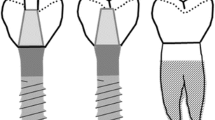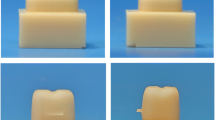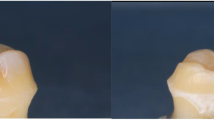Abstract
Objectives
The purpose of this study was to investigate the fracture resistance, flexural strength and Weibull modulus of an innovative CAD/CAM polymer and to compare its fracture resistance with that of glass ceramics.
Materials and methods
A total of 32 (n = 16 IPS e.max CAD (LIDI); n = 16 LuxaCam Composite (LUXA)) first mandibular molar crowns were fabricated and cemented onto metal dies by use of luting composite. Half of the specimens were loaded until fracture without prior artificial ageing. The other half were subjected to thermal (5°/55 °C) and mechanical (1,200,000 cycles, 80 N) cycling before fracture loading. Scanning electron microscopy was used to analyse fracture behaviour. A three-point bending test of the flexural strength of LUXA was performed according to ISO 6872:2008. Data were analysed by means of the Kolmogorov–Smirnov test, Mann–Whitney U-test (p < 0.05) and Weibull statistical analysis.
Results
Initial fracture resistance of LIDI was significantly higher than that of LUXA. However, the initial fracture resistance of LIDI decreased significantly after artificial ageing. After ageing, fracture resistance was 1050.29 ± 325.08 N for LUXA and 1250.09 ± 32.53 N for LIDI. Three-point bending test yielded a mean flexural strength value for LUXA of 145.28 ± 18.21 MPa and a Weibull modulus of m = 9.51.
Conclusions
Polymer-based material tested in this study had a lower fracture resistance than that of the glass-ceramic material. Fracture resistance and flexural strength of LuxaCam Composite are sufficient for use in the first molar region.
Clinical relevance
The mechanical properties of this innovative polymer-based material indicate it can be used in the first molar region as a suitable alternative to glass ceramics. Further clinical studies are required to confirm this.

The study presents an innovative material as an alternative to glassceramic for the clinical use in dentistry. The materials investigated were differently affected by artificial aging. Clinical use for patients with bruxism may be considered.





Similar content being viewed by others
References
Kapos T, Evans C. CAD/CAM technology for implant abutments, crowns, and superstructures. Int J Oral Maxillofac Implants. 2014;29:117–36.
Joda T, Bragger U, Zitzmann NU. CAD/CAM implant crowns in a digital workflow: five-year follow-up of a prospective clinical trial. Clin Implant Dent Relat Res. 2019;21:169–74.
Dahl BE, Dahl JE, Ronold HJ. Digital evaluation of marginal and internal fit of single-crown fixed dental prostheses. Eur J Oral Sci. 2018;126:512–7.
Fasbinder DJ. Computerized technology for restorative dentistry. Am J Dent. 2013;26:115–20.
Yin R, Kim YK, Jang YS, Lee JJ, Lee MH, Bae TS. Comparative evaluation of the mechanical properties of CAD/CAM dental blocks. Odontology. 2019;107:360–7.
Lambert H, Durand JC, Jacquot B, Fages M. Dental biomaterials for chairside CAD/CAM: state of the art. J Adv Prosthodont. 2017;9:486–95.
Alt V, Hannig M, Wostmann B, Balkenhol M. Fracture strength of temporary fixed partial dentures: CAD/CAM versus directly fabricated restorations. Dent Mater. 2011;27:339–47.
Stawarczyk B, Liebermann A, Eichberger M, Guth JF. Evaluation of mechanical and optical behavior of current esthetic dental restorative CAD/CAM composites. J Mech Behav Biomed Mater. 2015;55:1–11.
Shembish FA, Tong H, Kaizer M, et al. Fatigue resistance of CAD/CAM resin composite molar crowns. Dent Mater. 2016;32:499–509.
Goujat A, Abouelleil H, Colon P, et al. Mechanical properties and internal fit of 4 CAD-CAM block materials. J Prosthet Dent. 2018;119:384–9.
Awada A, Nathanson D. Mechanical properties of resin-ceramic CAD/CAM restorative materials. J Prosthet Dent. 2015;114:587–93.
Harada A, Nakamura K, Kanno T, et al. Fracture resistance of computer-aided design/computer-aided manufacturing-generated composite resin-based molar crowns. Eur J Oral Sci. 2015;123:122–9.
Rizo-Gorrita M, Herraez-Galindo C, Torres-Lagares D, Serrera-Figallo MA, Gutierre-Perez JL. Biocompatibility of polymer and ceramic CAD/CAM materials with human gingival fibroblasts (HGFs). Polymers. 2019;11:1446.
Wang H, Cui B, Li J, et al. J Adv Ceram. 2017;6:73. https://doi.org/10.1007/s40145-016-0214-0.
Tsitrou EA, Northeast SE, van Noort R. Brittleness index of machinable dental materials and its relation to the marginal chipping factor. J Dent. 2007;35:897–902.
Alamoush RA, Silikas N, Salim NA, Al-Nasrawi S, Satterthwaite JD. Effect of the composition of CAD/CAM composite blocks on mechanical properties. Biomed Res Int. 2018;2018:4893143.
Ivoclar vivadent. http://www.ivoclarvivadent.com/de/p/alle/vollkeramik/ips-emax-system-techniker/ips-emax-cad/ips-emax-cad-monolithic-solutions. 2019.
Sonmez N, Gultekin P, Turp V, Akgungor G, Sen D, Mijiritsky E. Evaluation of five CAD/CAM materials by microstructural characterization and mechanical tests: a comparative in vitro study. BMC Oral Health. 2018;18:5.
Ankyu S, Nakamura K, Harada A, et al. Fatigue analysis of computer-aided design/computer-aided manufacturing resin-based composite vs. lithium disilicate glass-ceramic. Eur J Oral Sci. 2016;124:387–95.
Schmitter M, Schweiger M, Mueller D, Rues S. Effect on in vitro fracture resistance of the technique used to attach lithium disilicate ceramic veneer to zirconia frameworks. Dent Mater. 2014;30:122–30.
Schmitter M, Mueller D, Rues S. Chipping behaviour of all-ceramic crowns with zirconia framework and CAD/CAM manufactured veneer. J Dent. 2012;40:154–62.
Bomicke W, Waldecker M, Krisam J, Rammelsberg P, Rues S. In vitro comparison of the load-bearing capacity of ceramic and metal-ceramic resin-bonded fixed dental prostheses in the posterior region. J Prosthet Dent. 2018;119:89–96.
Okada R, Asakura M, Ando A, et al. Fracture strength testing of crowns made of CAD/CAM composite resins. J Prosthodont Res. 2018;62:287–92.
Wolf D, Bindl A, Schmidlin PR, Luthy H, Mormann WH. Strength of CAD/CAM-generated esthetic ceramic molar implant crowns. Int J Oral Maxillofac Implants. 2008;23:609–17.
Varga S, Spalj S, Lapter Varga M, Anic Milosevic S, Mestrovic S, Slaj M. Maximum voluntary molar bite force in subjects with normal occlusion. Eur J Orthod. 2011;33:427–33.
Braun S, Bantleon HP, Hnat WP, Freudenthaler JW, Marcotte MR, Johnson BE. A study of bite force, part 1: Relationship to various physical characteristics. Angle Orthod. 1995;65:367–72.
Wendler M, Belli R, Valladares D, Petschelt A, Lohbauer U. Chairside CAD/CAM materials. Part 3: cyclic fatigue parameters and lifetime predictions. Dent Mater. 2018;34:910–21.
Tribst JPM, Alves LMM, Piva A, et al. Reinforced glass-ceramics: parametric inspection of three-dimensional wear and volumetric loss after chewing simulation. Braz Dent J. 2019;30:505–10.
Zandparsa R, El Huni RM, Hirayama H, Johnson MI. Effect of different dental ceramic systems on the wear of human enamel: an in vitro study. J Prosthet Dent. 2016;115:230–7.
Stona D, Burnett LH Jr, Mota EG, Spohr AM. Fracture resistance of computer-aided design and computer-aided manufacturing ceramic crowns cemented on solid abutments. J Am Dent Assoc. 2015;146:501–7.
Aboushelib MN, Elsafi MH. Survival of resin infiltrated ceramics under influence of fatigue. Dent Mater. 2016;32:529–34.
Schlichting LH, Maia HP, Baratieri LN, Magne P. Novel-design ultra-thin CAD/CAM composite resin and ceramic occlusal veneers for the treatment of severe dental erosion. J Prosthet Dent. 2011;105:217–26.
Zhi L, Bortolotto T, Krejci I. Comparative in vitro wear resistance of CAD/CAM composite resin and ceramic materials. J Prosthet Dent. 2016;115:199–202.
Rosentritt M, Raab P, Hahnel S, Stockle M, Preis V. In-vitro performance of CAD/CAM-fabricated implant-supported temporary crowns. Clin Oral Investig. 2017;21:2581–7.
Preis V, Hahnel S, Behr M, Rosentritt M. In vitro performance and fracture resistance of novel CAD/CAM ceramic molar crowns loaded on implants and human teeth. J Adv Prosthodont. 2018;10:300–7.
Rues S, Huber G, Rammelsberg P, Stober T. Effect of impact velocity and specimen stiffness on contact forces in a weight-controlled chewing simulator. Dent Mater. 2011;27:1267–72.
Author information
Authors and Affiliations
Corresponding author
Ethics declarations
Conflict of interest
The authors declare that they have no conflict of interest.
Additional information
Publisher’s note Springer Nature remains neutral with regard to jurisdictional claims in published maps and institutional affiliations.
Rights and permissions
About this article
Cite this article
Winter, A., Schurig, A., Rasche, E. et al. The flexural strength of CAD/CAM polymer crowns and the effect of artificial ageing on the fracture resistance of CAD/CAM polymer and ceramic single crowns. J Mater Sci: Mater Med 31, 9 (2020). https://doi.org/10.1007/s10856-019-6347-2
Received:
Accepted:
Published:
DOI: https://doi.org/10.1007/s10856-019-6347-2




